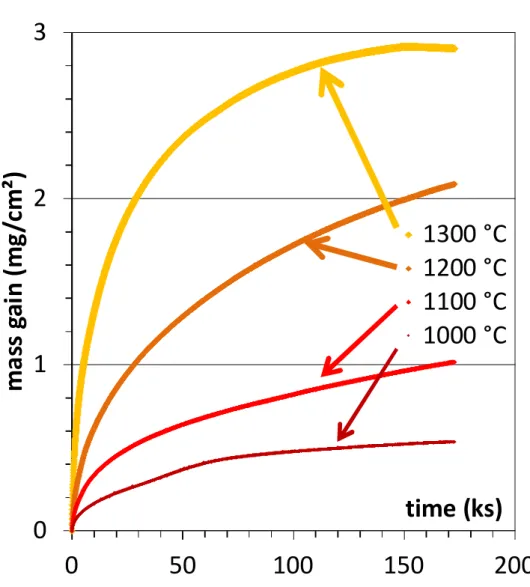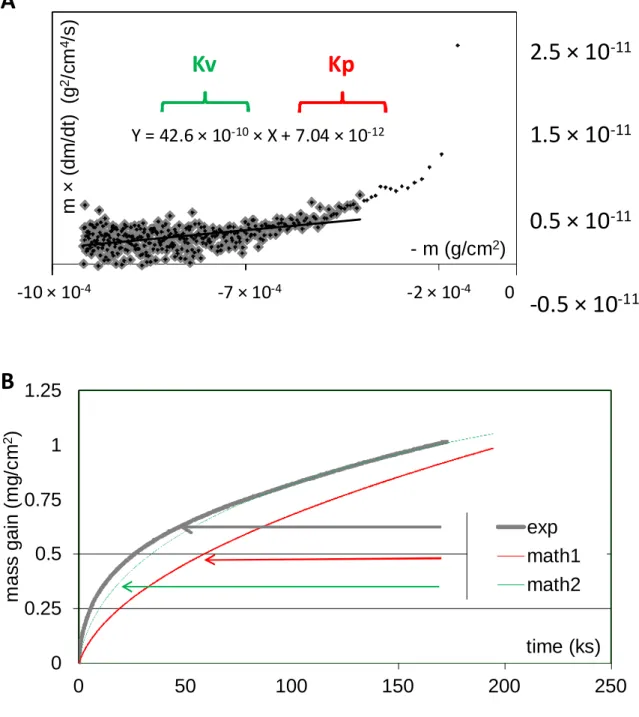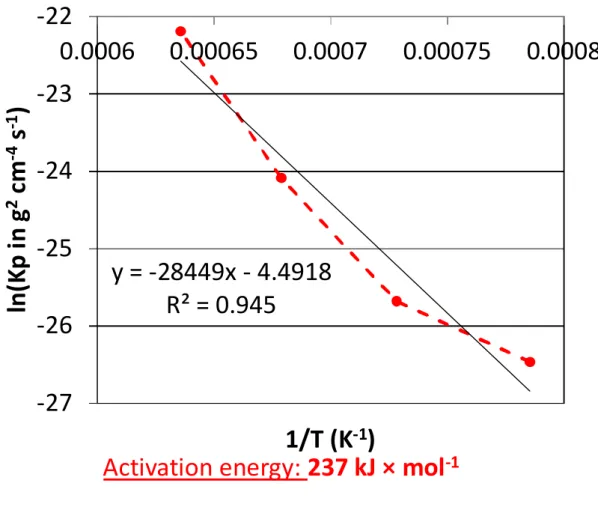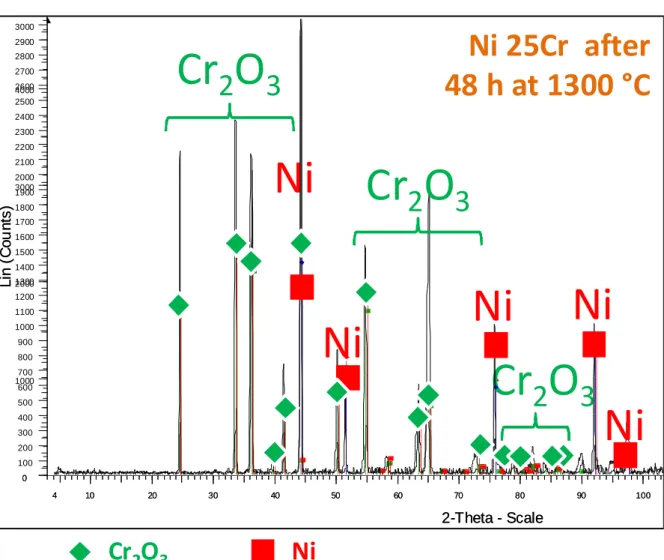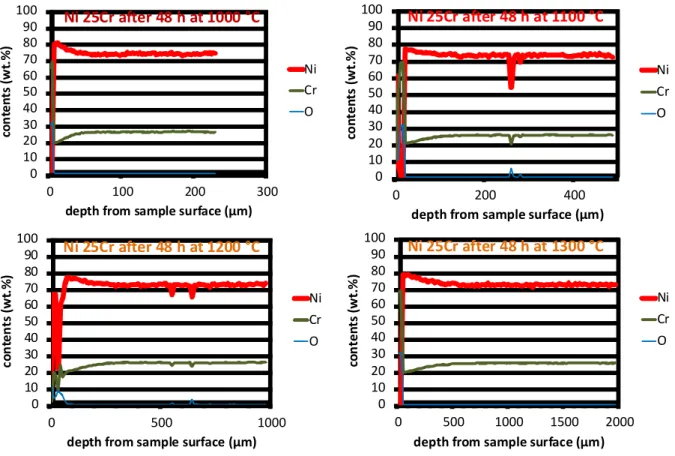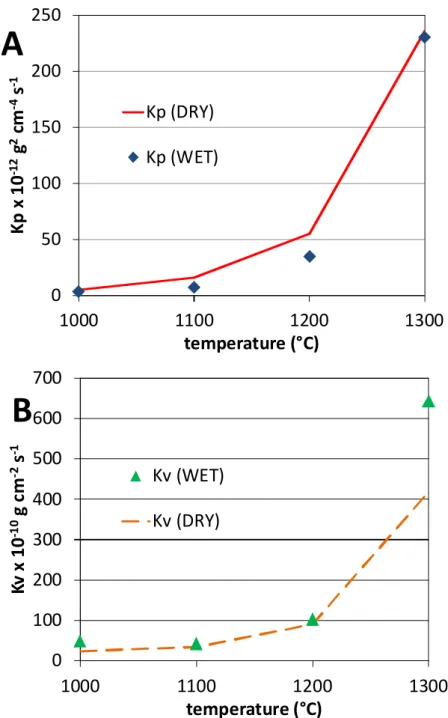HAL Id: hal-02878401
https://hal.archives-ouvertes.fr/hal-02878401
Submitted on 23 Jun 2020HAL is a multi-disciplinary open access archive for the deposit and dissemination of sci-entific research documents, whether they are pub-lished or not. The documents may come from teaching and research institutions in France or abroad, or from public or private research centers.
L’archive ouverte pluridisciplinaire HAL, est destinée au dépôt et à la diffusion de documents scientifiques de niveau recherche, publiés ou non, émanant des établissements d’enseignement et de recherche français ou étrangers, des laboratoires publics ou privés.
Kinetic and metallographic study of the oxidation at
high temperature of a cast Ni 25Cr alloy in water
vapour-rich air
Lionel Aranda, Ludovic Mouton, Sandrine Mathieu, Olivier Rouer, Pascal
Villeger, Patrice Berthod, Elodie Conrath
To cite this version:
Lionel Aranda, Ludovic Mouton, Sandrine Mathieu, Olivier Rouer, Pascal Villeger, et al.. Kinetic and metallographic study of the oxidation at high temperature of a cast Ni 25Cr alloy in water vapour-rich air. High Temperatures-High Pressures, Old City Publishing, 2015, 32, pp.530 - 538. �10.1179/1878641314Y.0000000041�. �hal-02878401�
Kinetic and metallographic study of the oxidation at high
temperature of a cast Ni 25Cr alloy in water vapour-rich air
Lionel Aranda1, Ludovic Mouton2, Sandrine Mathieu2, Olivier Rouer2, Pascal Villeger1, Patrice Berthod1,* and Elodie Conrath1
1
Institut Jean Lamour
Department N°2: Chemistry and Physic of Solids and Surfaces Team “Surface and interface, chemical reactivity of materials”
2
Common Service of Electronic Microscopy and Microanalysis Faculty of Sciences and Technologies, University of Lorraine
B.P. 70239, 54506 Vandoeuvre-lès-Nancy – France
*E-mail Address: pberthodcentralelille1987@orange.fr
Post-print version of the article Materials at High Temperatures 2015 VOL 32 N° 5 530–538.
DOI 10.1179/1878641314Y.0000000041
Abstract: The high temperature oxidation behaviour of a Ni 25 wt.% Cr alloy in air enriched with water vapour (180 mbars H2O) was studied at 1000,
1100, 1200 and 1300 °C. The oxidized samples were characterized by X-Ray diffraction, electron microscopy and wavelength dispersion spectroscopy. The obtained data were compared to the ones earlier obtained for the same alloy oxidized in dry air. W ater vapour globally induced at all temperatures a decrease of the parabolic constant Kp and an increase of the chromia volatilization constant Kv. The oxide scales do not present morphologic difference between the two atmospheres. After oxidation in humidified air the scale thickness is thinner and the Cr-depleted depth is lower than in dry air.
Keywords: nickel-chromium alloy, high temperature oxidation, water vapour,
thermogravimetry, kinetic parameters, metallographic characterization
1. Introduction
Superalloys are generally exposed to hot aggressive atmospheres when they are used in high temperature applications [1,2]. These atmospheres are often composed of air mixed with other oxidant gases as carbon oxides or water vapour notably [3,4]. W ater vapour plays a particularly important role in the oxidation of the hottest pieces of jet engines. Gaseous water forms during kerosene combustion (several % of combustion gases) and this proportion may be increased when the propelled planes fly through clouds or over sea. Furthermore, water vapour is present in much higher proportion in the steam turbines used for power generation.
The presence of water vapour may influence the high temperature oxidation which occurs for blades despite the low partial pressure in oxygen. Its influence on hot oxidation, when present in air or in other gases, was examined in many
earlier studies. This was notably done in the cases of pure metals [5,6], intermetallic compounds [7,8], metallic coatings [9], alloys based on heavy refractory metals [10] and even ceramic materials [11].
Water vapour influences the progress of oxidation of alloys at high temperature by modifying the structural characteristics of the externally growing oxide scales. There are then consequences on the rates of mass gain or of mass loss [12]. Effects of water vapour were also found concerning the adherence of the external scale on the alloy substrate during isothermal oxidation [13] as well as when temperature varies [14, 15], notably in thermal cycling situation.
The chromium-rich superalloys which resist high temperature oxidation and corrosion by molten substances by developing an external continuous chromia scale are especially sensitive to the presence of water vapour. Their protective Cr2O3 scale can be affected, in water vapour-containing hot gases, by a
re-oxidation [4] described by equation (1):
½ Cr2O3 (s) + H2O(g) + ¾ O2(g) → CrO2(OH)2(g) (1)
The oxy-hydroxides are volatile when temperature is high enough, but not so high as the 1000°C generally considered as required for the re-oxidation and volatilization of chromia (become gaseous CrO3) in dry air. Several works
showed that volatilization into gaseous CrO2(OH)2 may be significant at
temperatures not higher than 600°C for binary [16] or commercial [17] iron-based chromia-forming alloys, for example. Such volatilization phenomenon induces, when the oxidation progress is followed by thermogravimetry, a decrease in mass gain rate leading to an underestimation of the oxidation kinetic. This is the reason why the treatment of the mass variations recorded by the thermobalance needs the separation of: on the one hand the parabolic contribution of the oxidation of the alloy, and on the other hand the linear mass loss due to chromia volatilization. Taking into account the linear mass loss by volatilization of chromia allows better characterizing the kinetic of high temperature oxidation of the alloy. Indeed, valuing the volatilization constant Kv allows avoiding to underestimate the parabolic constant Kp. Specifying simultaneously the real value of Kp and the linear constant Kv is thus very important. Such double determination can be done by treating the thermogravimetric results by applying in the present case a method which was previously established for the determination of the same constants in case of oxidation in dry air [18].
In this work it was wished to study the general kinetic of oxidation of chromia forming alloy in air enriched with water vapour at different levels of temperature, by performing thermogravimetry runs and by exploiting the obtained mass variations files according to the method described by equation (2) [18]:
m × (dm / dt) = Kp - m × Kv (2)
where m is the mass gain per surface unit area, t is time, Kp is the kinetic parabolic constant and Kv the kinetic linear constant which represents the rate of mass loss due to chromia volatilization.
The alloy taken in consideration for this work was a cast Ni (bal.) – 25 wt.% Cr one. It was chosen for its simple chemical composition (possible oxides: only of Cr and of Ni), its chromia forming behaviour existing up to very high temperature and its excellent resistance against local scale detachment due to growth-induced stresses. The goal was to compare the obtained kinetic constants, as well as the oxide characteristics of the oxidized samples, to the corresponding data obtained in parallel for the same alloy in dry air.
2. Experimental
2.1. The studied alloy
Four compact ingots (mass: about 40 g) were prepared by high frequency induction melting of pure nickel and pure chromium (Alfa Aesar, purity > 99.9 %) under inert atmosphere (300 mbars of pure Argon) in a CELES furnace (50 kW, operating parameters: 4 kV and 100 kHz). Two parallelepiped samples were prepared per test temperature: one for the test in humidified air and one for the test in dry air (for comparison). They were cut in each ingot (dimensions: about: 10 × 10 × 3 mm3) by the mean of a Buehler Isomet 5000 precision saw. These samples were grinded all around with SiC papers from 240-grid to 1200 grid. Careful smoothing of their edges and corners was realized in order to avoid any risk of local catastrophic oxidation and to favour oxide adherence. 2.2. The thermogravimetry tests and their numerical treatment
All thermogravimetry tests were carried out with the same apparatus, a SETARAM SETSYS thermo-balance, coupled with a WETSYS vapour generator. Per ingot a sample was oxidized in “dry air” (industrial 80 % N2 20 %
O2, no water added) and another one was oxidized in “wet air” (industrial 80 %
N2 20 % O2 with addition of water). In the second case, water was introduced in
air to achieve a partial pressure of 179 mbars. This was done by generating 90 % of relative humidity at 60 °C in the initial dry air before introduction in the thermobalance. The thermal cycle was composed of a heating with a rate of +20 °C min-1, a {48 hours}-long isothermal stage at 1000, 1100, 1200 or 1300 °C, and a cooling with a rate of -5 °C min-1.
The obtained thermogravimetry files were first visualized by plotting the mass gain versus time to control if the kinetic is globally parabolic. Second they were analysed by plotting the same data but according to equation (2) in order to value the two kinetic constants Kp and Kv. Plotting m × (dm / dt) versus -m effectively leads, for m become sufficiently important, to a straight line. The ordinate at origin of this one then led to Kp while its slope led to Kv.
2.3. Metallographic characterization of surfaces
The oxidized surfaces were first observed to get some qualitative data concerning the adherence of the oxide scale on the metallic samples (fraction of denuded alloy). Thereafter X-Ray Diffraction (Philips X’Pert Pro diffractometer; wavelength of the Kα transition of copper: λ = 1.5406 Angströms) was carried out on the surface of the oxidized samples before cutting, to identify the nature of the oxide scales externally formed. Thereafter, the external scales were
subjected to carbon deposition and their general morphology was observed at high magnification, using scanning electron microscopy (Hitachi S4800 or JEOL JSM-7600F Field Emission Scanning Electron Microscopes).
2.4. Metallographic characterization in cross-section
The oxidized samples were coated all around with a thin gold layer using cathodic sputtering (Fine coater JEOL JFC 1200). This was done to allow thereafter the electrolytic deposition of a thick nickel layer in a heated Watts’ bath, the role of which was protecting the oxide scale against possible degradation during cutting. The coated samples were cut in two parts using the Isomet 5000 precision saw. They were embedded in a cold resin mixture (ESCIL, araldite resin CY230 + hardener HY956), before being grinded with SiC papers from 120-grit to 1200-grit, ultrasonically cleaned, and polished again with 1µm paste to obtain a mirror-like surface state.
The oxide scales were observed in cross-section and their thickness measured, using a SEM (JEOL JSM6010LA). Their natures were confirmed by Energy Dispersion Spectrometry (EDS) using the EDS device equipping the SEM. Wavelength Dispersion Spectrometry profiles were performed across the alloy sub-surface to characterize the chromium-depleted zones: chromium content in the sub-surface close to the alloy/scale interface, and depth of Cr-impoverishment in the alloy.
3. Results
3.1. Thermogravimetry results
The four mass gain curves are presented together in Figure1. All are globally parabolic and the mass gain kinetic is logically faster for a higher stage temperature. These kinetics are all typical of a chromia-forming behaviour at each of these four temperatures. The curve form is not totally parabolic. For example the curve obtained at the lowest temperature (1000 °C) is a little irregular (affected by some oxide detachments). The one obtained at the highest temperature (1300 °C) presents an almost horizontal end part (obviously due to intense chromia volatilization).
By assuming that the Ni 25Cr oxidation progressed with chromia nucleation then growth, the mass gain data were treated according to equation (2). Two examples of such {m × (dm / dt) versus –m} plots are given in Fig. 2A (1100 °C) and Figure 3A (1300 °C). The four graphs effectively contained a linear part. A regression straight line was determined, the equation of which gave the value of Kp (ordinate at the origin) and Kv (slope). The obtained values are displayed in Table 1. The volatilization constant Kv logically increases with temperature, from about 50 to 640 × 10-10 g cm-2 s-1 between 1000 and 1300 °C. The parabolic constant Kp – thus corrected from the underestimation induced by chromia volatilization – also increases between 1000 and 1300 °C (3 to 230 × 10-12 g2 . cm-4 . s-1). These values determined for Kp and Kv were thereafter verified by comparing, to the experimental mass gain curves, the model curves calculated using these Kp and Kv values. In all cases, the obtained {Kp, Kv} couples led to theoretic curves (called “math2” in the figures). They fit very well
the experimental curves (examples in Figure 2B for 1100 °C and Figure 3B for 1300 °C). There was not the case of the mathematical curves which would be obtained with classically determined Kp values (called “math1” in the figures).
The obvious dependence of the two constants on temperature was thereafter analysed by plotting the natural logarithm of these constants versus the reciprocal temperature (Arrhenius representation). This was done by considering the four temperatures for Kp but only the three highest ones for Kv. Indeed, the value of the volatilization constant obtained at 1000°C, curiously slightly higher than the one determined for the 100°C-higher temperature, is probably induced by the irregularities seen in Figure 1.
This led to points which are almost aligned, the regression straight lines of which allow proposing values for the activation energies: 237 kJ × mol-1 for Kp and 241 kJ × mol-1 for Kv. These values are very close to one another and are typical of a limitation of the oxidation kinetic by the diffusion of cationic vacancies.
3.2. Metallographic characterization of the oxidized surfaces
Preliminary observation of the oxidized surface showed that oxide scale spallation was more or less severe during the post-isothermal stage cooling. The surface fraction of denuded alloy increased with the temperature stage. For example, no significant loss of oxide was observed for the two samples cooled from 1000 °C while the denuded alloy surface fraction was the greatest for the two samples cooled from 1300 °C. In addition to the isothermal stage temperature it also appeared that humidity of air influenced the scale spallation during cooling. Indeed, for a given isothermal stage temperature, spallation was generally a little less severe in wet air than in dry air. These optical observations were confirmed by the analysis of the mass variation files during cooling (curves plotted versus temperature more or less irregular).
The SEM examination of the oxidized surfaces before cross-section preparation reveals that the average grain size of the chromia scale tends to increase with the oxidation temperature, as illustrated by the micrographs presented in Figure 6. The four oxidized samples were also subjected to X-ray diffraction runs. They all showed that chromia is the single oxide present on the sample surfaces, as illustrated in Figure 7 (sample oxidized at 1000 °C) and Figure 8 (1300 °C) for the two extreme temperatures. This confirms what was suggested by the mass gain and parabolic constants which were both typical of a chromia-forming behaviour. One can also notice in the diffractograms the presence of other peaks (noted “Ni”). These ones correspond to the austenitic nickel-based matrix of the alloy, appearing here and there on the surface of the samples where scale spallation during cooling led to zones of denuded alloy. 3.3. Metallographic characterization of cross-sections
After cross section preparation, the SEM examinations of oxide scales were realized through their thickness. Figure 9 presents SEM micrographs for the four oxidized samples. The oxide scale is exclusively made of chromia as verified by the homogeneous darkness of the whole thickness. This was confirmed by several EDS pinpoint measurements. A porosity state exists in the
chromia scales. The thickness of this scale logically increases with the isothermal stage temperature.
Two W DS concentration profiles were acquired in the subsurface, perpendicularly to the alloy/oxide interface. A profile per sample is shown in Figure 10 for example. The chromium content in the sub-surface close to the alloy/scale interface does not vary systematically versus the temperature of the isothermal stage. In contrast the alloy zone in which the chromium content had decreased during oxidation is obviously deeper for a higher temperature.
4. Discussion
The alloy under study here usually presents a very good behaviour in dry air for the same temperatures and for similar durations. The presence of a significant content of water vapour in air did not deteriorate this basis good behaviour (chromia-forming). The mass gains kinetic are fundamentally all of the parabolic type and if some of them are not exactly parabolic it is only due to chromia volatilization. The oxidation rates, considered by taking into account the more or less high temperature, are seemingly not considerably changed by comparison with oxidation in dry air. In addition the presence of water vapour seemed improving the resistance against oxide scale spallation during cooling. However some small differences may exist and it appeared interesting to directly compare the present kinetic and metallographic data to the corresponding ones obtained in a parallel work. This is done graphically thereafter.
The Kp and Kv values obtained in the present study (“WET”) and in a parallel work (“DRY”) are plotted together in Figure 11 (A: Kp, B: Kv) versus temperature. One can see that the parabolic constants issued from the {m × (dm / dt) = f(–m)} plots and treatments tend to be lower for oxidation in humidified air than in dry air. In contrast, the volatilization constants are rather close to one another for the lowest stage temperatures tested here. In contrast the value obtained for Kv at 1300 °C is significantly higher in humidified air than in dry air. The particularly high value of volatilization constant obtained at 1300 °C in the present work explains the apparent stationarity of the mass gain near the end of the isothermal stage (Figure 1).
Thus the presence of water vapour influenced the hot oxidation behaviour of the alloy. This concerned first the growth rate of the continuous external chromia scale, and second the rate of the loss of a part of this chromia oxide by volatilization. It also influenced the nature of the oxide scales since the ones covering the four samples of the present study were of pure chromia as demonstrated by XRD diffractograms. The presences of NiO and NiCr2O4 were
in parallel additionally detected, by XRD measurements too, for the same alloy oxidized in dry air in the same conditions. In contrast the morphologies of the outer surface of the oxide scales formed in humidified air were not really different from the ones appeared on the parallel samples in dry air (illustrated by the SEM micrographs presented in Figure 12). This is in good agreement with previous results obtained about chromia scales formed in dry and wet atmospheres on binary Ni 25Cr alloys [19].
Additional differences between humidified air (this work) and dry air (parallel work) are highlighted in Figure 13 for the oxide scale thickness (A: significantly lower when formed in humidified air than in dry air) and for the Cr-depleted depth in the alloy subsurface (C: depletion depths lower for humidified air than for dry air). In contrast, no systematic difference was seen about the chromium content in the sub-surface close to the alloy / scale interface (B).
To summarize, the presence of water vapour with a partial pressure of about 180 mbars did not significantly transform the high temperature oxidation behaviour of the Ni 25Cr alloy by comparison with dry air, notably at the three lowest temperatures. However some differences were found, for example concerning the parabolic rate a little slower at all temperatures in wet air than in dry air. On the other hand the chromia volatilization was slightly enhanced at 1000 °C because air humidity, but the effect was much stronger at 1300 °C. At this latter temperature, the presence of water induced a significant acceleration of the volatilization of chromia. The effects of water vapour on the parabolic constant (which is lower in wet air than in dry air at 1100 and 1200 °C) and on the chromia volatilization constant (which is higher in wet air than in dry air at 1000 °C and at 1300 °C) contributed to the fact that the oxide scale thickness observed after oxidation in humidified air is lower than in dry air.
5. Conclusion
When the one-fifth of the atmospheric pressure is constituted by water vapour the general oxidation behaviour of this binary Ni 25Cr alloy is thus modified by comparison with its behaviour in dry air but not in great proportions. The modifications are, for some of them, a little detrimental. For example, more chromium initially belonging to the alloy is lost in gaseous species. But this is compensated by the better properties which are obviously brought to the external oxide scales by the fact that it grew in humidified air: nature exclusively chromia, lower diffusion of species through the scale as suggested by the lower values of Kp… Additionally the adherence of the scale on the alloy seems being better in humidified air than in dry air [14, 15]. Thus, the presence of water vapour in hot air seems being rather beneficial for the general oxidation behaviour of this alloy. This may be perhaps extrapolated to more complex chromia-forming refractory alloys and superalloys. However this remains to be verified but, in their cases, the possible oxidation of several metallic elements other than chromium risk to do not permit to follow the same procedure of {Kp, Kv} determination as used in the present work. Other means of chromia volatilization evaluation will be then used.
6. References
[1] Sims, C.T. (1972) Cobalt-Base Alloys. In: Sims, C.T. and Hagel, W.C. (eds), The Superalloys, pp. 150-174. John Wiley & Sons, New York.
[2] Donachie, M.J. and Donachie, S.J. (2002) Superalloys, A Technical Guide (2nd edition), ASM International, Materials Park.
[3] Kofstad, P. (1988) High Temperature Corrosion, Elsevier Applied Science, London.
[4] Young, D.J. (2008) High Temperature Oxidation and Corrosion of Metals (1st edition), Elsevier Corrosion Series, Amsterdam.
[5] Jonsson, T., Pujilaksono, B., Hallström, S., Agren, J., Svensson, J.E., Johansson, L.G., Halvarsson, M. An ESEM in situ investigation of the influence of H2O on iron oxidation at 500 °C. Corrosion Science, 51,
1914-1924 (2009).
[6] Pérez, P. On the influence of water vapour on the oxidation behaviour of pure Ti. Corrosion Science, 49, 1172-1185 (2007).
[7] Chevalier, S., Juzon, P., Przybylski, K., Larpin, J.P. Water vapor effect on high-temperature oxidation behavior of Fe3Al intermetallics. Science and
Technology of Advanced Materials, art. n°045006, 10 (2009).
[8] Lin, Z.J., Li, M.S., Wang, J.Y., Zhou, Y.C. Influence of water vapor on the oxidation behavior of Ti3AlC2 and Ti2AlC. Scripta Materialia, 58, 29-32
(2008).
[9] Kaplin, C., Brochu, M. Effects of water vapor on high temperature oxidation of cryomilled NiCoCrAlY coatings in air and low-SO2 environments.
Surface and Coatings Technology, 205, 4221-4227 (2011).
[10] Hellström, K., Tang, J.E., Jonsson, T., Halvarsson, M., Pompe, R.,
Sundberg, M., Svensson, J.E. Oxidation behaviour of a (Mo, W )Si2-based composite in dry and wet oxygen atmospheres in the temperature range 350-950 °C. Journal of the European Ceramic Society, 29, 2105-2118 (2009).
[11] Yamauchi, A., Yi, X.M., Akiyama, T., Kurokawa, K. Oxidation Behavior of
β-SiAlON in H2O-Containing Atmosphere. Materials Science Forum, 696,
395-399 (2011).
[12] Saunders, S. R. J., Monteiro, M., Rizzo, F. The oxidation behaviour of metals and alloys at high temperatures in atmospheres containing water vapour: A review. Progress in Materials Science, 53, 775-837 (2008). [13] Othman, N. K., Othman, N., Zhang, J., Young, D. J. Effects of water vapour
on isothermal oxidation of chromia-forming alloys in Ar/O2 and Ar/H2
atmospheres. Corrosion Science, 51, 3039-3049 (2009).
[14] Zurek, J., Young, D. J., Essuman, E., Hänsel, M., Penkalla, H. J.,
Niewolak, L., Quadakkers, W. J. Growth and adherence of chromia based surface scales on Ni-base alloys in high- and low-pO2 gases. Materials
Science and Engineering A, 477, 259-278 (2008).
[15] Michalik, M., Hansel, M., Zurek, J., Singhheiser, L., Quadakkers, W. J. Effect of water vapour on growth and adherence of chromia scales formed on Cr in high and low pO2-environments at 1000 and 1050°C. Materials at
High Temperature, 22, 213-221 (2005).
[16] Jonsson, T., Pujilaksono, B., Heidari, H., Liu, F., Svensson, J.-E., Halvarsson, M., Johansson, L.-G. Oxidation of Fe-10Cr in O2 and in
O2+H2O environment at 600°C: A microstructural investigation. Corrosion
Science, 75, 326-336 (2013).
[17] Halvarsson, M., Tang, J. E., Asterman, H., Svensson, J.-E., Johansson, L.-G. Microstructural investigation of the breakdown of the protective oxide
scale on a 304 steel in the presence of oxygen and water vapour at 600°C. Corrosion Science, 48, 2014-2035 (2006).
[18] Berthod, P. Kinetics of high temperature oxidation and chromia
volatilization for a binary Ni–Cr alloy. Oxidation of Metals, 64(3/4), 235-252 (2005).
[19] Essuman, E., Meier, G. H., Zurek, J., Hänsel, M., Norby, T., Singheiser, L., Quadakkers, W. J. Protective and non-protective scale formation of NiCr alloys in water vapour containing high- and low-pO2 gases. Corrosion
TABLES
Table 1
Values of the kinetic constants derived from the {m × (dm / dt) = f(-m)} plot of the thermogravimetric results
Temperature Kp (×10-12 g2 . cm-4 . s-1) Kv (×10-10 g . cm-2 . s-1) 1300 °C 230 643 1200 °C 34.5 103 1100 °C 7.04 42.6 1000 °C 3.21 48.7 Table 2
Values of the thickness of the external oxide scales (in µm)
Temperature average standard deviation
1300 °C 30.8 5.0
1200 °C 11.7 1.5
1100 °C 6.8 0.9
1000 °C 5.8 2.5
Table 3
Values of the chromium content in extreme surface (in wt.%)
Temperature average standard deviation
1300 °C 19.4 0.3
1200 °C 17.9 1.9
1100 °C 19.9 0.5
1000 °C 18.3 0.8
Table 4
Values of the depth of the Cr-depleted zone (in µm)
Temperature average standard deviation
1300 °C 455 43
1200 °C 197 7
1100 °C 96 7
FIGURES
0
1
2
3
0
50
100
150
200
m
a
ss
g
a
in
(
m
g
/c
m
²)
time (ks)
1300 °C
1200 °C
1100 °C
1000 °C
Fig. 1. The thermogravimetry curves obtained for the four temperatures of oxidation of the Ni 25Cr alloy in wet air
y = 4.26E-09x + 7.04E-12
-5.0E-12
5.0E-12
1.5E-11
2.5E-11
-1.E-03
-7.E-04
-2.E-04
m
×
(d
m
/d
t)
(g
2/c
m
4/s
)
- m (g/cm
2)
0
0.25
0.5
0.75
1
1.25
0
50
100
150
200
250
m
a
s
s
g
a
in
(
m
g
/c
m
2)
time (ks)
exp
math1
math2
A
Kp
Kv
B
2.5 × 10
-111.5 × 10
-110.5 × 10
-11-0.5 × 10
-11-10 × 10
-4-7 × 10
-4-2 × 10
-40
Y = 42.6 × 10
-10× X + 7.04 × 10
-12Fig. 2. Example of the thermogravimetry results at 1100 °C: {m × (dm / dt) = f(-m)} plot of the mass gain records (A) for the determination of the constants Kp
and Kv; test of the conventionally obtained Kp constant and of the {Kp, Kv} couple of constants values issued from the {m × (dm / dt) = f(-m)} plot
0
0.5
1
1.5
2
2.5
3
3.5
0
50
100
150
200
250
m
a
s
s
g
a
in
(
m
g
/c
m
2)
time (ks)
exp math1 math2y = 6.43E-08x + 2.30E-10
-1.0E-10
0.0E+00
1.0E-10
2.0E-10
3.0E-10
4.0E-10
-0.004
-0.003
-0.002
-0.001
0
m
×
(d
m
/d
t)
(g
2/c
m
4/s
)
- m (g/cm
2)
A
B
Kp
Kv
4 × 10
-103 × 10
-102 × 10
-101 × 10
-100
1 × 10
-10-4 × 10
-3-3 × 10
-3-2 × 10
-3-1 × 10
-30
Y = 643 × 10
-10× X + 230 × 10
-12Fig. 3. Example of the thermogravimetry results at 1300°C: {m × (dm / dt) = f(-m)} plot of the mass gain records (A) for the determination of the constants Kp
and Kv; test of the conventionally obtained Kp constant and of the {Kp, Kv} couple of constants values issued from the {m × (dm / dt) = f(-m)} plot
y = -28449x - 4.4918
R² = 0.945
-27
-26
-25
-24
-23
-22
0.0006
0.00065
0.0007
0.00075
0.0008
ln
(K
p
i
n
g
2cm
-4s
-1)
1/T (K
-1)
Activation energy: 237 kJ × mol
-1Fig. 4. Arrhenius plot of the parabolic constant Kp (issued from the {m × (dm / dt) = f(-m)} plot); determination of the activation energy
y = -29040x + 1.6989
R² = 0.9443
-20
-19
-18
-17
-16
0.0006
0.00065
0.0007
0.00075
0.0008
ln
(K
v
i
n
g
c
m
-2s
-1)
1/T (K
-1)
y = -29040x + 1.6989
R² = 0.9443
-20
-19
-18
-17
-16
0.0006
0.00065
0.0007
0.00075
0.0008
ln
(K
v
i
n
g
c
m
-2s
-1)
1/T (K
-1)
Activation energy: 241 kJ × mol
-1Fig. 5. Arrhenius plot of the parabolic constant Kv (issued from the {m × (dm / dt) = f(-m)} plot); determination of the activation energy
L in (C o u n ts ) 0 1 00 2 00 3 00 4 00 5 00 6 00 7 00 8 00 9 00 1 000 1 100 1 200 1 300 1 400 1 500 1 600 1 700 1 800 1 900 2 000 2 100 2 200 2 300 2 400 2 500 2 600 2 700 2 800 2 900 3 000 2-Theta - Scale 4 10 20 3 0 40 50 60 70 80 90 1 00
Ni 25Cr after
48 h at 1000 °C
Ni
Ni
Ni
Ni
Ni
Cr
2
O
3
Cr
2
O
3
Cr
2
O
3
Cr
2O
3Ni
Fig. 7. Diffractogram obtained for the external oxide scale formed over the sample oxidized at 1000 °C
ber169 Ni25Cr1300°Chum2
L in ( C o u n ts ) 0 1000 2000 3000 4000 2-Theta - Scale 4 10 20 30 40 50 60 70 80 90 100Ni-25Cr 48h 1300°C
Ni
Ni
Ni
Ni
Ni
Cr
2
O
3
Cr
2
O
3
Cr
2
O
3
L in ( C o u n ts ) 0 100 200 300 400 500 600 700 800 900 1000 1100 1200 1300 1400 1500 1600 1700 1800 1900 2000 2100 2200 2300 2400 2500 2600 2700 2800 2900 3000 2-Theta - Scale 4 10 20 30 40 50 60 70 80 90 100Ni 25Cr after
48 h at 1300 °C
Cr
2O
3Ni
Fig. 8. Diffractogram obtained for the external oxide scale formed over the sample oxidized at 1300 °C
Ni 25Cr after 48 h 1000 °C
Ni 25Cr after 48h at 1100 °C
Ni 25Cr after 48 h at 1200 °C
Ni 25Cr after 48 h at 1300 °C
electrolytic Ni layer
Cr
2O
3Cr
2O
3Cr
2O
3Cr
2O
30 10 20 30 40 50 60 70 80 90 100 0 500 1000 1500 2000 co n te n ts ( w t. % )
depth from sample surface (µm)
Ni Cr O 0 10 20 30 40 50 60 70 80 90 100 0 500 1000 c o n te n ts ( w t. % )
depth from sample surface (µm)
Ni Cr O 0 10 20 30 40 50 60 70 80 90 100 0 200 400 co n te n ts ( w t. % )
depth from sample surface (µm)
Ni Cr O 0 10 20 30 40 50 60 70 80 90 100 0 100 200 300 co n te n ts ( w t. % )
depth from sample surface (µm)
Ni Cr O
Ni 25Cr after 48 h at 1000 °C Ni 25Cr after 48 h at 1100 °C
Ni 25Cr after 48 h at 1200 °C Ni 25Cr after 48 h at 1300 °C
Fig. 10. Concentration profiles acquired through the Cr-depleted zones of the four oxidized samples
0
100
200
300
400
500
600
700
1000
1100
1200
1300
K
v
x
1
0
-1 0g
c
m
-2s
-1temperature (°C)
Kv (WET)
Kv (DRY)
0
50
100
150
200
250
1000
1100
1200
1300
K
p
x
1
0
-1 2g
2cm
-4s
-1temperature (°C)
Kp (DRY)
Kp (WET)
A
B
Fig. 11. Comparison of the kinetic constants of the Ni 25Cr alloy at the four temperatures between wet air and dry air (A: Kp, B: Kv)
40 µm
40 µm
40 µm
40 µm
1300 °C dry
1200 °C dry
1100 °C dry
1000 °C dry
Fig. 12. SEM micrographs of the outer oxide scales formed over the Ni 25Cr samples in dry air during 48 h at the four temperatures
0 10 20 30 40 50 1000 1100 1200 1300 sc a le t h ic k n e ss ( µ m )
temperature of the isothermal stage (°C)
Ni-25Cr in wet air WET DRY 0 5 10 15 20 25 1000 1100 1200 1300 ch ro m iu m c o n te n t in t h e s u b su rf a ce c lo se t o t h e a ll o y /s ca le i n te rf a ce ( w t. % )
temperature of the isothermal stage (°C)
Ni-25Cr in wet air
WET DRY 0 100 200 300 400 500 600 1000 1100 1200 1300 c h ro m iu m -d e p le te d d e p th ( µ m )
temperature of the isothermal stage (°C)
Ni-25Cr in wet air
WET DRY
A
B
C
Fig. 13. Comparison of the scales’ thicknesses (A), the alloy chromium contents
in extreme surface (B) and the Cr-depleted depths (C) of the Ni 25Cr alloy at
